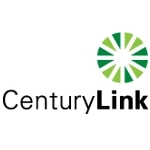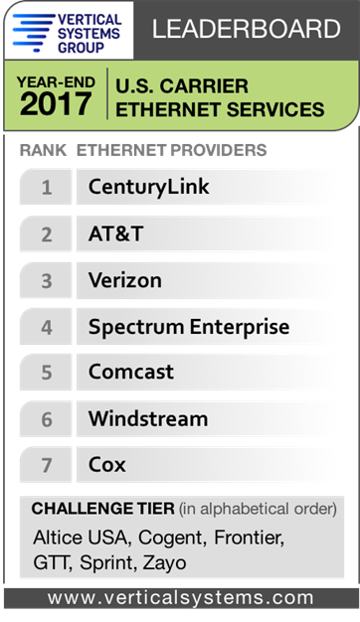 In its year-end 2017 Carrier Ethernet Leaderboad, Vertical Systems Group announced a major change. For the first time since 2005, a company rather than AT&T has captured the top spot, with CenturyLink now in first place.
In its year-end 2017 Carrier Ethernet Leaderboad, Vertical Systems Group announced a major change. For the first time since 2005, a company rather than AT&T has captured the top spot, with CenturyLink now in first place.
CenturyLink’s ascendency was made possible by its merger in November 2017 with Level 3 and the parallel growth in ports billed for by both companies. In the last edition of the Leaderboard, Level 3 ranked second and CenturyLink ranked fifth.
“In addition to the shakeup at the top of the LEADERBOARD, U.S. Ethernet installations exceeded the milestone of one million ports in 2017,” said Rick Malone, the principal of Vertical Systems Group, in a press release. “Overall, the fastest growing Ethernet deployments were driven by higher speed cloud connectivity and IP VPN access. Service providers cite price compression as a continuing challenge, as well as delayed network purchase decisions due to SD-WAN evaluations.”
AT&T now is second in the listing, followed by Verizon, Spectrum Enterprise, Comcast, Windstream and Cox. Network providers must garner at least 4% of the domestic Ethernet services market as measured by billable retail customer ports to be included.

Highlights of the latest Vertical Systems Leaderboard include:
- The U.S. retail Ethernet port base grew 13% in 2017 and finished the year with more than one million ports.
- Seven Ethernet providers qualified for the 2017 LEADERBOARD, as compared to nine in 2016. The two company exits were XO (acquired by Verizon) and Level 3 (merged with CenturyLink). As a result, the U.S. LEADERBOARD has no companies from the Competitive Provider segment for the first time.
- Four Incumbent Carriers (CenturyLink, AT&T, Verizon, Windstream) and three Cable MSOs (Spectrum Enterprise, Comcast, Cox) are represented on the latest LEADERBOARD.
- Comcast had the highest organic growth of the LEADERBOARD companies in 2017, growing its base of Ethernet ports appreciably without an acquisition.
- Six Ethernet providers qualified for the 2017 Challenge Tier, as compared to four in 2016. New entrants Frontier and GTT moved up into the Challenge Tier from the Market Player tier based in part on acquisitions of Ethernet assets. These companies join Altice USA, Cogent, Sprint and Zayo.
- Each of the seven LEADERBOARD companies has attained MEF CE 2.0 Ethernet services certification, and each employs MEF Carrier Ethernet Certified Professionals (MEF-CECPs). Spectrum Enterprise leads with more than 800 MEF-CECPs, followed by CenturyLink with greater than 500. Companies on the U.S. Ethernet LEADERBOARD plus Challenge Tier employ more than one-third of the 5,500+ MEF-CECPs worldwide.
Vertical Systems Group offered two other classes of providers. The Challenge Tier focuses on providers with between 1% and 4% share. At the end of 2017, they were (in alphabetical order) Altice, USA, Cogent, Frontier, GTT, Sprint and Zayo.
The Market Player tier features those with less than 1%. Those providers (also in alphabetical order) are Alaska Communications, Alpheus Communications, American Telesis, Birch Communications, BT Global Services, Cincinnati Bell, Consolidated Communications, Crowne Castle, DQE Communications, Expedient, FiberLight, FirstLight, Global Cloud Xchange, Great Plains Communications, Hawaiian Telecom, Logix Fiber Networks, LS Networks, Lumos Networks, Masergy, MegaPath, Midco, NTT America, Orange Business, RCN Business, Tata, TDS Telecom, Telstra, TPx Communications, Unite Private Networks, US Signal and WOW!Business.
Image courtesy of flickr user Yuri Samoilov.


